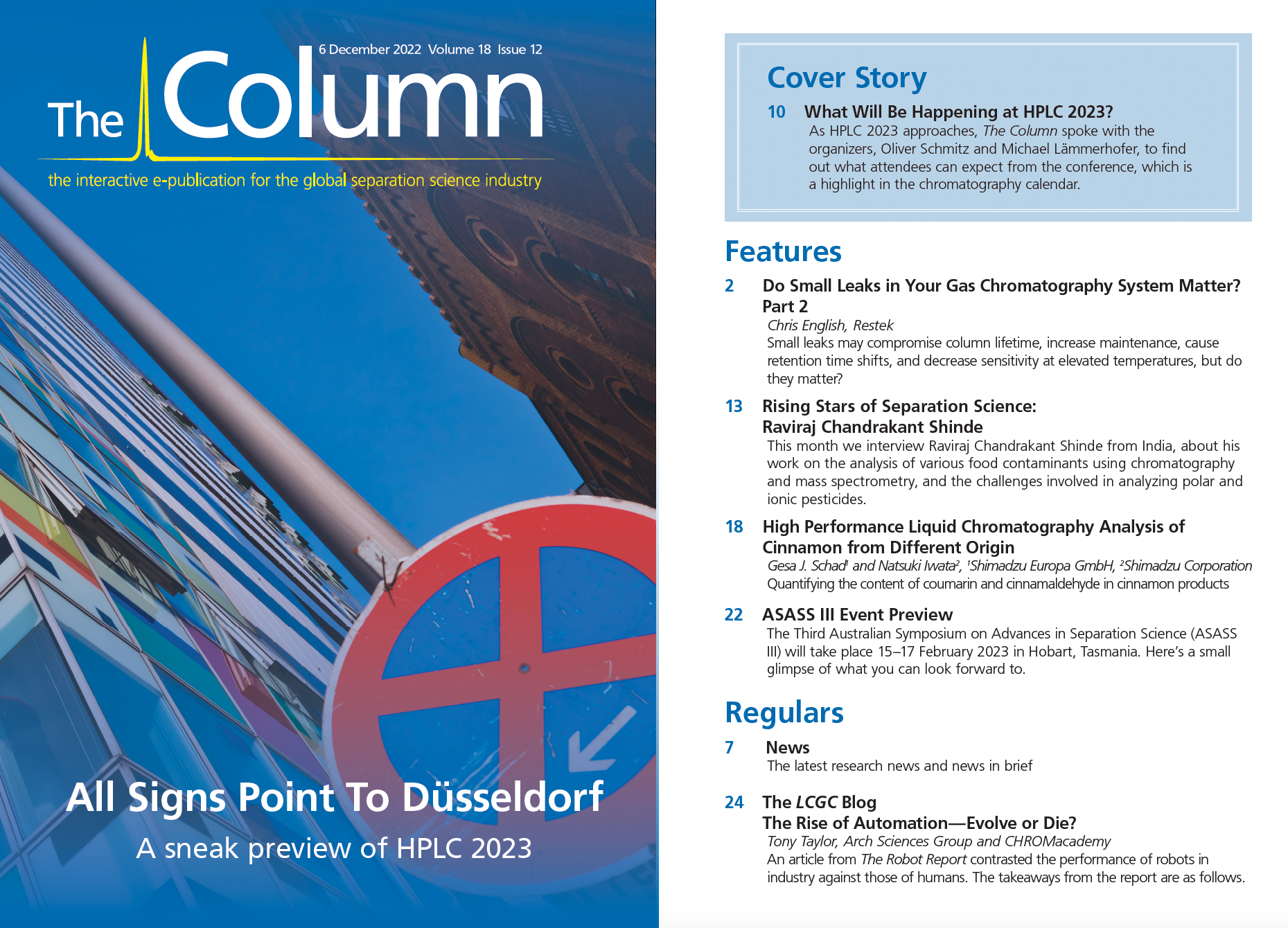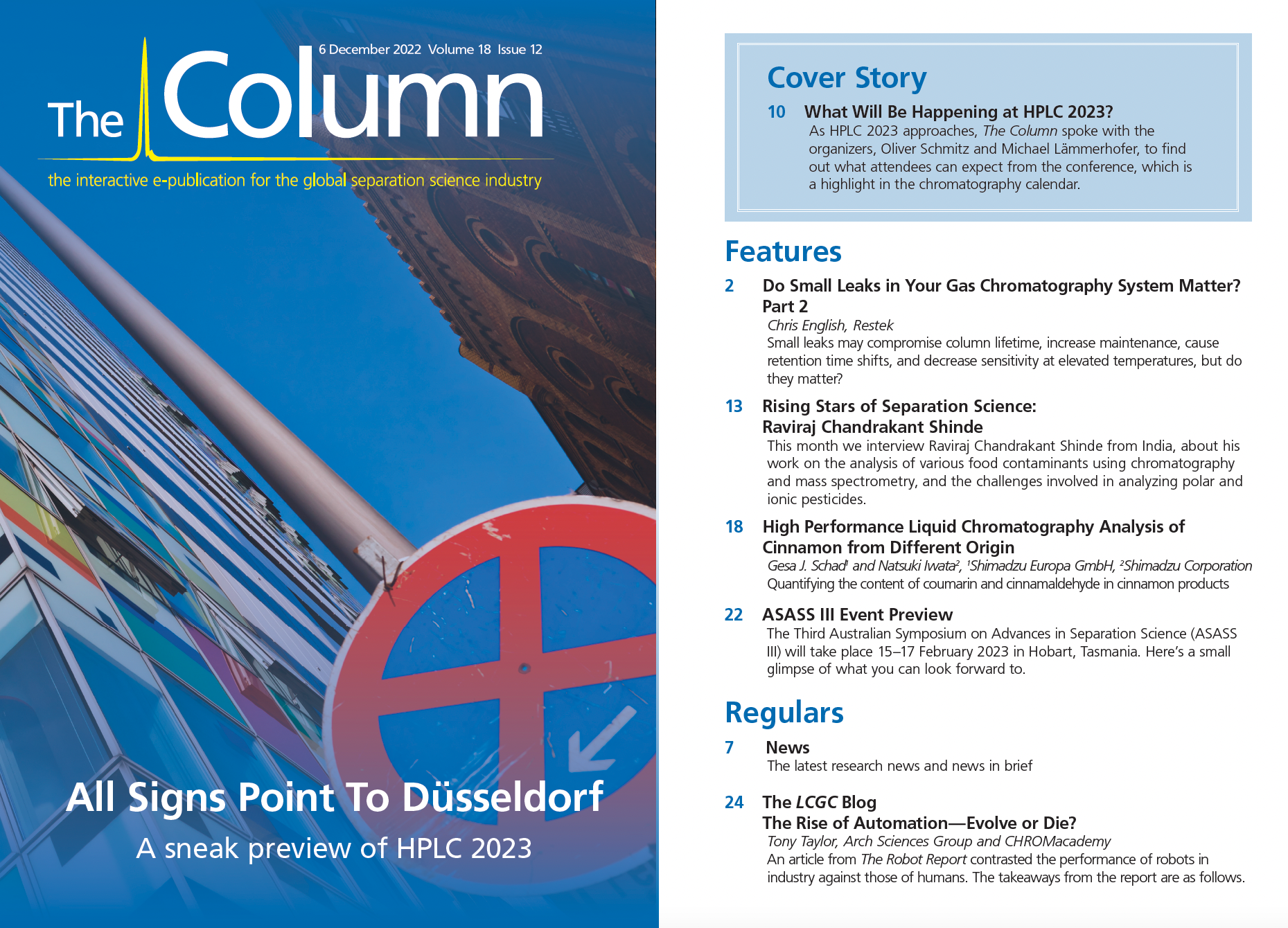The Rise of Automation—Evolve or Die?
In the article from The Robot Report (1), five areas were highlighted where robots perform better than humans: a) handling tedium, b) extreme sensing, c) strength and speed, d) unwavering focus, and e) perfect, objective recall.
The article also highlighted three areas where humans still outperform robots: a) empathy, b) flexibility, and c) acceptability and trust.
It strikes me that considering these points within the laboratory context, we may not be taking full advantage of the positive aspects of robotics, or indeed working to address the negative aspects. This is especially true when considering sample preparation and sample manipulation.
Most laboratory workers with more than just a few samples to process will be familiar with the daily routine of preparing samples, setting up equipment, running a system suitability, checking fitness for purpose, and then starting the “batch” of samples just before leaving work for the evening. Modern instruments have very much reduced the amount of finger crossing required on the journey home and that sense of anticipation as one enters the laboratory the next morning to see if the “run has worked” or not, but those feelings of anxiety have not been completely eliminated. Automated robotics have the power to change this paradigm, with samples being prepared in a “just-in-time” fashion so that the analysis can begin at the start of the day, and much of it will be done as we leave work—preparation and analysis times permitting. We could then even rack up enough samples to do the same thing overnight, hence improving our throughput, if required.
Of course, we need the automated solutions to be very robust and reliable, and this is perhaps where the industry needs to evolve, to ensure that our engineering is optimized to the point at which fallibility is not a consideration. Again, most of us are familiar with situations where campaigns have been halted overnight due to a vial not being gripped or picked up properly, or a vial tolerance that has caused the autosampler to reject a particular sample, or even simply to drop the vial. Here evolution in the flexibility and “learning” of the instruments could be improved. Provided that the rejected vial does not lie in a dangerous or obstructive position, the robot should be able to move to the next operation and simply flag the failure in the batch report, provided the sample is not a key system suitability or quality control (QC), which may render the remainder of the analyses invalid.
There is a myriad of situations in which robotics can be used for sample preparation in high performance liquid chromatography (HPLC) and will produce a better result than the human laboratory worker might otherwise manage. Operations such as sample dilution (including serial dilution), filtration, and derivatization are all possible. There are sample robotics that can handle weighing, mixing, and even centrifugation, yet I don’t see these solutions being employed in many HPLC laboratories and I wonder why? I can state with certainty that the robot will follow a sample preparation or extraction protocol with much greater precision than a human if it has been properly “trained”. It will also follow the standard operating procedure (SOP) every time. Can we honestly say that we follow the SOP for every sample preparation that we undertake? Always shaking for the precise time, using the same method of agitation, using the same spot in the sonic bath, weighing or pipetting using exactly the correct technique—I could go on! Robots are infallible in terms of recall and repeatability, we are not.
While many sample preparation or extraction protocols in HPLC are relatively straightforward, there are those that are not so simple, such as solid-phase extraction (SPE) or more complex liquid–liquid extraction (LLE) protocols. Method development is a time-consuming and costly activity, involving the systematic exploration of variables, with the aim of finding the optimum set of conditions for a robust method that yields data of an appropriate quality and cost. In method development, it is vital to vary the parameters under investigation in a stepwise fashion, automatically, and tightly fix all other parameters, so that the effect of varying a target parameter isn’t obscured by random variations elsewhere. Manual sample preparation is a significant source of unwanted variation and automating sample preparation—making method development a more straightforward and predictable process—saves a great deal of time. With more analysts taking a design of experiment (DoE) approach (where several parameters are adjusted simultaneously in a systematic way) to method development, automated sample preparation is a logical partner to reduce these unwanted variations but again, I don’t see widespread implementation and it really puzzles me as to why.
Could it be that we consider sample preparation for HPLC too simple? Not worthy of automation because it can be quickly and easily achieved within the sample preparation laboratory? Ask yourself how many batch failures or laboratory investigations have been related to issues with sample preparation?
You will note that up to this point I have concentrated on liquid chromatography for this discussion. I think the gas chromatography (GC) marketplace may be slightly different, more evolved even. There are several manufacturers producing advanced robotics systems for the preparation and manipulation of samples prior to GC analysis, and the complexity of the systems is much more advanced than I typically see allied to HPLC instruments. Furthermore, the systems are fully integrated and can inject the sample into the GC system, with just-in‑time sample preparation capabilities. These systems are equipped with many tools that enable weighing, mixing, shaking, heating, centrifugation, solvent evaporation, and a host of other options. This enables operations such as sample dilution, addition of internal standards, derivatization, LLE, solid-phase microextraction (SPME), SPE, and other micro‑extraction techniques to be automated.
Even in situations where large sample volumes were traditionally used, such as environmental analysis, automation has been made possible because of advances in mass spectrometric detection technology and sensitivity, which can be achieved using detectors such as triple quadrupole (QQQ) and quadrupole time-of-flight (QTOF) instruments. Essentially, the increase in detector sensitivity enables much smaller volumes of samples to be processed without compromising limits of detection or quantitation. Of course, this reduction in sample volume also means that the automated version of these techniques is not only greener (lower volumes of organic extraction solvents), but is achieved within the chromatographic run time, enabling “just‑in‑time” sample processing for all but the most complex preparation or extraction protocols.
Perhaps this latter point highlights a potential issue with the interfacing of HPLC to robotic auto sampling procedures. With the advent of ultrahigh-pressure liquid chromatography (UHPLC), chromatographic run times are typically very short, and lengthy sample preparation protocols would not match the time frame of the separative phase and the overall analysis time may be extended. Here the “batch preparation” robotics with multi‑head probes used in bioanalysis (mentioned earlier) may have the edge because the overall campaign time may be reduced. However, when the benefits of improved fidelity, reproducibility, and unattended operation (from fully integrated robotic solutions) are considered, even one sample at a time approaches may still be of considerable benefit in HPLC analysis. Miniaturized sample preparation protocols can be very rapid indeed when using modern automated systems with optimized processing workflows.
So, what is preventing further implementation of robotic solutions in the GC laboratory, or the wider scale adoption of robotic approaches in the HPLC laboratory?
Below, I’ve listed reasons typically cited for low adoption of automation, specifically regarding sample preparation for chromatography analysis, as well as a short response for each.
- Not enough budget for automation? Did you carry out a return on investment (ROI) calculation that included an improvement in right first time and a reduction in solvents and the energy to power fume hoods if these are used as part of your current sample preparation routine?
- Tried automation before and it didn’t deliver the promised benefits? Did you work with the manufacturer of the robotic system to fully explore the time, materials, and cost savings?
- My process couldn’t be automated I rarely encounter a sample preparation routine that cannot be automated with modern laboratory systems. As I’ve said above, SPE, LLE, weighing, sonication, centrifugation, heating, shaking, dilution, desorption, evaporation, reconstitution, and a host of other tasks can be completed using automated systems.
- My sample preparation is very straightforward, and I can’t justify the spend to automate something so simple Did you work with the manufacturer of the robotic system to fully explore the time, materials, and cost savings? Did you consider what that analytical chemist or technician could be doing while they aren’t doing sample preparation?
- Automated approaches can’t meet my sensitivity requirements This is invariably not the case when the sensitivity of modern mass spectrometry and other detectors are considered, and the workflow optimized to result in a sample of low enough volume to produce a robust detector response.
I don’t trust automation; it adds more complexity and susceptibility Nothing is more complex or susceptible as a human. The repeatability, accuracy, and relative infallibility of modern robotic systems for sample preparation may be worthy of suspicion for their unerring performance, but I would find it difficult to question their susceptibility.
I have perhaps left the most important emerging driver for automation to last, that of the Environmental, Sustainability, and Governance (ESG) agenda. As a society we are becoming “greener in our mindsets”, and while we may consider the major business wins in the green agenda to lie outside the laboratory, believe me, these initiatives are coming to a laboratory near you very soon. The reduction in power, solvent volumes, and exposure of analytical staff to potentially harmful solvents and reagents are clear when using automated platforms. They fit the ESG agenda perfectly and allow us to clearly demonstrate that we take the future of the planet very seriously! There are several analytical “greenness” calculators available; however, one that I particularly favour is from a collaborative group that includes the sample preparation impact of the method and can be found at this link (2): https://mostwiedzy.pl/pl/wojciech-wojnowski,174235-1/agreeprep
Revisiting the title of this piece, do we need to evolve or die? Of course, it’s a fact of every species on the planet. How true is this of automation of sample preparation for chromatographic applications? Well okay, I like to use a shocking title to draw in the reader; however, the flexibility of modern automated systems and the range of tasks they can complete has been revolutionized, even in the past 10 years. Their unfaltering accuracy and repeatability is proven, and their ability to reduce worker exposure to both tedium and hazardous reagents or operations can also be clearly demonstrated.
Do we then just fear the “rise of the robots”? Surely not in our modern society, and I encourage you to further investigate the upsides of automation that, hopefully, I’ve been able to point out in this blog.
References
- https://www.therobotreport.com/5-things-robots-better-humans/
- W. Wojnowski et al., TrAC 149, 116553 (2022).
Tony Taylor is Chief Scientific Officer of Arch Sciences Group and Technical Director of CHROMacademy.

New Study Reviews Chromatography Methods for Flavonoid Analysis
April 21st 2025Flavonoids are widely used metabolites that carry out various functions in different industries, such as food and cosmetics. Detecting, separating, and quantifying them in fruit species can be a complicated process.
Extracting Estrogenic Hormones Using Rotating Disk and Modified Clays
April 14th 2025University of Caldas and University of Chile researchers extracted estrogenic hormones from wastewater samples using rotating disk sorption extraction. After extraction, the concentrated analytes were measured using liquid chromatography coupled with photodiode array detection (HPLC-PDA).

.png&w=3840&q=75)

.png&w=3840&q=75)



.png&w=3840&q=75)



.png&w=3840&q=75)












